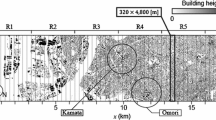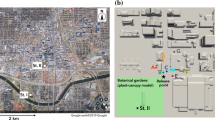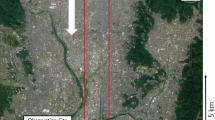Abstract
We used numerical simulations to investigate the general relationship between urban morphology and the intensity of wind gusts in built-up areas at the pedestrian level. The simulated urban boundary layer developed over a 19.2 km (length) \(\times \) 4.8 km (width) \(\times \) 1.0 km (height) simulation domain, with 2-m resolution in all directions, to explicitly resolve the detailed shapes of buildings and the flow at the pedestrian level. This complex computation was accomplished using the lattice Boltzmann method and by implementing a large-eddy simulation model. To generalize the results, a new parameter that expresses the intensity of gusts (the gust index, \({\tilde{U}}_{ max})\) was defined as the local maximum wind speed divided by the freestream velocity. In addition, this parameter was decomposed into the mean wind-speed ratio, \({\tilde{U}} \) and turbulent gust ratio, \({\tilde{U}}^{{\prime }}\) to evaluate the qualities of gusts. These parameters were useful for quantitatively comparing the gust intensities within urban canopies at different locations or even among different experiments. In addition, the entire horizontal domain was subdivided into homogeneous square patches, in which both the simulated gust parameters and the morphological characteristics of building geometries were averaged. This procedure masked the detailed structure of individual buildings but retained the bulk characteristics of the urban morphology. At the pedestrian level, the gust index decreased with increasing building cover. Compared to \({\tilde{U}} \), the quantity \({\tilde{U}}^{{\prime }}\) notably contributed to the index throughout the range of plan area index \((\lambda _p)\) values. The dependences of all normalized wind-speed ratios transiently changed at \(\lambda _p =~0.28\). In cases where \(\lambda _p < 0.28, {\tilde{U}} \) decreased with increasing \(\lambda _p \), although \({\tilde{U}}^{{\prime }}\) was almost constant. In cases where \(\lambda _p > 0.28, {\tilde{U}}\) was almost constant and \({\tilde{U}}^{{\prime }}\) decreased with increasing \(\lambda _p \). This was explained by the change in flow regimes within the building canyon. At a higher elevation above the canopy layer, \(\lambda _p \) becomes less relevant to normalized wind-speed ratios, and instead the aerodynamic roughness length became important.









Similar content being viewed by others
References
Azad AK, Alam MM (2010) Determination of wind gust factor at windy areas of Bangladesh. In: 13th Asian congress of fluid mechanics, 17–21 December, 2010, IUT, Dhaka, Bangladesh, pp 521–524
Bernaschi M, Fatica M, Melchionna S, Succi S, Kaxiras E (2010) A flexible high-performance lattice Boltzmann GPU code for the simulations of fluid flows in complex geometries. Concurr Comput Pract Exp 22(1):1–14
Castillo MC, Inagaki A, Kanda M (2011) The effects of inner-and outer-layer turbulence in a convective boundary layer on the near-neutral inertial sublayer over an urban-like surface. Boundary-Layer Meteorol 140(3):453–469
Coceal O, Belcher SE (2004) A canopy model of mean winds through urban areas. Q J R Meteorol Soc 130(599):1349–1372
Counihan J (1971) Wind tunnel determination of the roughness length as a function of the fetch and the roughness density of three-dimensional roughness elements. Atmos Environ 5:637–642
He J, Song CCS (1999) Evaluation of pedestrian winds in urban area by numerical approach. J Wind Eng 81:295–309
He X, Zou Q, Luo LS, Dembo M (1997) Analytic solutions of simple flows and analysis of nonslip boundary conditions for the lattice Boltzmann BGK model. J Stat Phys 87(1–2):115–136
Hou S, Sterling J, Chen S, Doolen GD (1994) A lattice Boltzmann subgrid model for high Reynolds number flows. arXiv:comp-gas/9401004
Hu T, Yoshie R (2013) Indices to evaluate ventilation efficiency in newly-built urban area at the pedestrian level. J Wind Eng Ind Aerodyn 112:39–51
Inagaki A, Castillo MCL, Yamashita Y, Kanda M, Takimoto H (2012) Large-eddy simulation of coherent flow structures within a cubical canopy. Boundary-Layer Meteorol 142(2):207–222
Jiménez J (2004) Turbulent flows over rough walls. Annu Rev Fluid Mech 36:173–196
Kanda M (2006) Large-eddy simulations on the effects of surface geometry of building arrays on turbulent organized structures. Boundary-Layer Meteorol 118(1):151–168
Kanda M, Inagaki A, Miyamoto T, Gryschka M, Raasch S (2013) A new aerodynamic parameterization for real urban surfaces. Boundary-Layer Meteorol 148(2):357–377
Kanda M, Moriwaki R, Kasamatsu F (2004) Large-eddy simulation of turbulent organized structures within and above explicitly resolved cube arrays. Boundary-Layer Meteorol 112(2):343–368
Keck M, Raasch S, Letzel MO, Ng E (2014) First results of high resolution large-eddy simulations of the atmospheric boundary layer. J Heat Island Inst Int 9(2):39–43
Kobayashi H, Ham F, Wu X (2008) Application of a local SGS model based on coherent structures to complex geometries. Int J Heat Fluid Flow 29(3):640–653
Kobayashi H (2006) Large-eddy simulation of magnetohydrodynamic turbulent channel flows with local subgrid-scale model based on coherent structures. Phys Fluids 18(4):045107
Kubota T, Miura M, Tominaga Y, Mochida A (2008) Wind tunnel tests on the relationship between building density and pedestrian-level wind velocity: development of guidelines for realizing acceptable wind environment in residential neighborhoods. Build Environ 43:1699–1708
Leonardi S, Castro IP (2010) Channel flow over large cube roughness: a direct numerical simulation study. J Fluid Mech 651:519–539
Letzel MO, Helmke C, Ng E, An X, Lai A, Raasch S (2012) LES case study on pedestrian level ventilation in two neighbourhoods in Hong Kong. Meteorol Z 21(6):575–589
Letzel MO, Krane M, Raasch S (2008) High resolution urban large-eddy simulation studies from street canyon to neighbourhood scale. Atmos Environ 42(38):8770–8784
Macdonald RW (2000) Modelling the mean velocity profile in the urban canopy layer. Boundary-Layer Meteorol 97(1):25–45
Martilli A, Clappier A, Rotach MW (2002) An urban surface exchange parameterisation for mesoscale models. Boundary-Layer Meteorol 104(2):261–304
Martinuzzi R, Tropea C (1993) The flow around surface-mounted, prismatic obstacles placed in a fully developed channel flow (Data Bank Contribution). J Fluids Eng 115(1):85–92
Monahan HH, Armendariz M (1971) Gust factor variations with height and atmospheric stability. J Geophys Res 76(24):5807–5818
Murakami S, Fujii K (1983) Turbulence characteristics of wind flow at ground level in built-up area. J Wind Eng Ind Aerodyn 15:133–144
Nakayama H, Takemi T, Nagai H (2011) LES analysis of the aerodynamic surface properties for turbulent flows over building arrays with various geometries. J App Meteorol Clim 50(8):1692–1712
Oke TR (1987) Boundary layer climates, 2nd edn. Methuen, London 435 pp
Onodera N, Aoki T, Shimokawabe T, Kobayashi H (2013) Large-scale LES wind simulation using lattice Boltzmann method for a 10 km \(\times \) 10 km area in metropolitan Tokyo. TSUBAME e-Sci J Global Sci Inf Comput Cent 9:1–8
Park SB, Baik JJ, Han BS (2015) Large-eddy simulation of turbulent flow in a densely built-up urban area. Environ Fluid Mech 15:235–250
Razak AA, Hagishima A, Ikegaya N, Tanimoto J (2013) Analysis of airflow over building arrays for assessment of urban wind environment. Build Environ 59:56–65
Roth M (2000) Review of atmospheric turbulence over cities. Q J R Meteorol Soc 126(564):941–990
Takebayashi H, Oku K (2014) Study on the evaluation method of wind environment in the street canyon for the preparation of urban climate map. J Heat Island Inst Int 9(2):55–60
Verkaik JW (2000) Evaluation of two gustiness models for exposure correction calculations. J Appl Meteorol 39(9):1613–1626
Wieringa J (1973) Gust factors over open water and built-up country. Boundary-Layer Meteorol 3(4):424–441
Wilson DK (2000) The role of wind gusts in the near-ground atmosphere (No. ARL-TR-2290). Army Res Lab Adelphi MD
Xie Z, Castro IP (2006) LES and RANS for turbulent flow over arrays of wall-mounted obstacles. Flow Turbul Combust 76(3):291–312
Xie ZT, Coceal O, Castro IP (2008) Large-eddy simulation of flows over random urban-like obstacles. Boundary-Layer Meteorol 129(1):1–23
Yin X, Zhang J (2012) An improved bounce-back scheme for complex boundary conditions in lattice Boltzmann method. J Comput Phys 231(11):4295–4303
Yu H, Girimaji SS, Luo LS (2005) DNS and LES of decaying isotropic turbulence with and without frame rotation using lattice Boltzmann method. J Comput Phys 209(2):599–616
Zaki SA, Hagishima A, Tanimoto J, Ikegaya N (2011) Aerodynamic parameters of urban building arrays with random geometries. Boundary-Layer Meteorol 138(1):99–120
Zou Q, He X (1996) On pressure and velocity flow boundary conditions and bounce back for the lattice Boltzmann BGK model. eprint. arXiv:comp-gas/9611001
Acknowledgements
This research was supported by Japan Society for the Promotion of Science (JSPS) KAKENHI Grant Nos. 25249066 and 26420492 and was partially supported by the Joint Usage/Research Center for Interdisciplinary Large-scale Information Infrastructures and High-performance Computing Infrastructure in Japan.
Author information
Authors and Affiliations
Corresponding author
Appendix: Comparison of the Present LBM–LES Model to a Previous Wind-Tunnel Experiment and the Navier–Stokes LES Model
Appendix: Comparison of the Present LBM–LES Model to a Previous Wind-Tunnel Experiment and the Navier–Stokes LES Model
Letzel et al. (2008) validated the parallelized large-eddy simulation model (PALM) by comparing PALM results with wind-tunnel results from Martinuzzi and Tropea (1993). This suggested that PALM accurately reproduces flow around a single cube in a wind tunnel and we followed this validation study in comparing our LBM-based model with PALM and the wind-tunnel experiment.
The airflow around an isolated cube (shown in Fig. 9) was modelled using both numerical methods, and had previously been conducted in a wind-tunnel experiment. Moreover, PALM is an established model for atmospheric boundary-layer studies of flat and real cities (e.g., Inagaki et al. 2012; Letzel et al. 2012; Kanda et al. 2013; Keck et al. 2014; Park et al. 2015).
Figure 10 shows the vertical distribution of the average wind-speed ratio between the main flow, U and the inflow, \(U_b \) obtained from the simulation results. The profiles were plotted for several locations (i.e., before, in the middle and after the cube). A number of different grid resolutions, N, were applied to the simulation, and profiles were in good agreement with the experimental results with increasing grid resolution.
Vertical profiles of the average wind speed, U, normalized to the bulk inflow cross-section average wind speed, \(U_b\). Experimental data are represented by the dotted lines. Each profile represents the position mentioned in Fig. 9
The vertical (cube centre) and horizontal (bottom layer) cross-sections of the time-averaged streamline are shown in Fig. 11. In the vertical cross-section when \(N = 32\), a swirling flow line near the bottom of the cube on the downwind side can be observed. Such a streamline was not reproduced under coarser spatial resolutions. However, the streamlines for the horizontal cross-section did not greatly differ, regardless of the domain resolution.
Figure 12 shows a comparison of the vertical profile of \(U/U_b \) computed with PALM and LBM–LES models. Different resolutions (i.e., N = 16, 32 and 64) were used in both simulations, with PALM and LBM–LES profiles fitting well when N = 64 for all locations. However, the domain resolution of the actual simulation conducted herein was fixed to 2 m (N = 32), which was homogeneous in all directions, to reduce the time and cost of the computation.
Rights and permissions
About this article
Cite this article
Ahmad, N.H., Inagaki, A., Kanda, M. et al. Large-Eddy Simulation of the Gust Index in an Urban Area Using the Lattice Boltzmann Method. Boundary-Layer Meteorol 163, 447–467 (2017). https://doi.org/10.1007/s10546-017-0233-6
Received:
Accepted:
Published:
Issue Date:
DOI: https://doi.org/10.1007/s10546-017-0233-6







